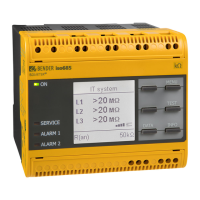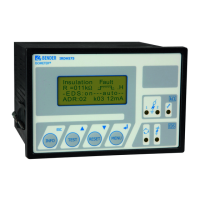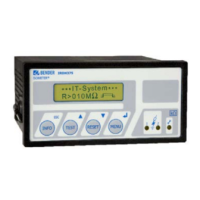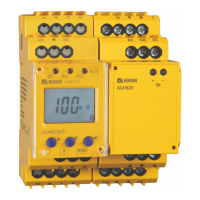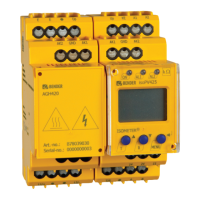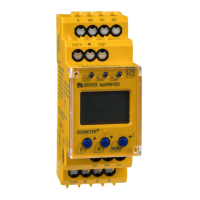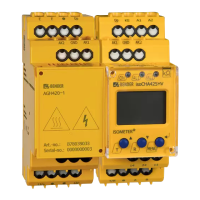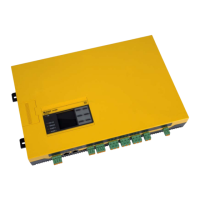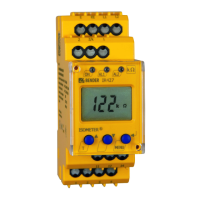12 iso685-x_D00022_12_Q_INTE/12.2023
ISOMETER® iso685…
i
The profile “power circuits” is suitable for most of
the IT systems. For a description of the profiles refer
to the manual.
i
The relays are de-energised until the commission-
ing process is finished.
Alarm and its effect
Cause of the alarm
• Insulation fault: The insulation resistance is below
both response values (LED ALARM 1, ALARM 2)
• Device error (LED SERVICE)
• Active insulation fault location (iso685-x-P, PGH ON)
Device signals alarm or device error
• Display indicates error and measured value.
• In the event of an alarm the associated LEDs flash.
• A warning sound beeps at intervals, if assigned.
• Assigned alarm relays will switch.
• Assigned digital outputs will switch.
Reset alarm messages (Reset)
• Requirement: The cause of the alarm is no longer
present. The insulation resistance must be at least
25 % higher than the response value.
• Select: “RESET” > “RESET” > “OK”.
Factory settings
Response values
Response value R
an1
(Alarm 1) ...............................................................40 kΩ
Response value R
an2
(Alarm 2) ...............................................................10 kΩ
Fault memory ............................................................................................off
Coupling monitoring ..................................................................................on
Device profile ........................................................................ “Power circuits”
Type of system to be monitored
System type ............................................................................................. 3AC
Time response
Start-up delay T
Anlauf
...................................................................................0 s
Switching elements
Relay 1
Operating principle .................................................................. N/C operation
Function 1 ................................................................................... Ins. Alarm 1
Function 2 ................................................................................................. aus
Function 3 ............................................................................Connection fault
Relay 2
Operating principle .................................................................. N/C operation
Function 1 ................................................................................... Ins. Alarm 1
Function 2 ....................................................................................Device fault
Function 3 ............................................................................Connection fault
i
Das Profil „Leistungskreise“ ist für die meisten IT-
Systeme geeignet. Eine Beschreibung der Profile
finden Sie im Handbuch.
i
Bis der Inbetriebnahme-Assistent abgeschlossen ist,
sind die Relais abgefallen.
Der Alarm und seine Wirkung
Ursachen für eine Alarmmeldung
• Isolationsfehler: Isolationswiderstand unterschreitet
beide Ansprechwerte (LED ALARM 1, ALARM 2)
• Gerätefehler (LED SERVICE)
• Isolationsfehlersuche aktiv (iso685-x-P, PGH ON)
Gerät meldet Alarm bzw. Gerätefehler
• Display zeigt Fehler und Messwert an.
• Bei Alarm leuchten die zugehörigen LEDs.
• Alarmton ertönt intervallweise, wenn zugeordnet.
• Zugeordnete Alarmrelais schalten.
• Zugeordnete digitale Ausgänge schalten.
Alarmmeldungen zurücksetzen (Reset)
• Voraussetzung: Ursache für Alarmmeldung be-
steht nicht mehr. Isolationswiderstand muss min-
destens 25 % über dem Ansprechwert liegen.
• Wählen Sie: „RESET“ > „RESET“ > „OK“.
Werkseinstellungen
Ansprechwerte
Ansprechwert R
an1
(Alarm 1) ................................................................. 40 kΩ
Ansprechwert R
an2
(Alarm 2) ................................................................. 10 kΩ
Fehlerspeicher...........................................................................................aus
Ankoppelüberwachung ............................................................................. ein
Geräteprofil .........................................................................„Leistungskreise“
Art des zu überwachenden Netzes
Netzform ..................................................................................................3AC
Zeitverhalten
Anlaufverzögerung T
Anlauf
...........................................................................0 s
Schaltglieder
Relais 1
Arbeitsweise ........................................................................Ruhestrom (N/C)
Funktion 1 ................................................................................... Iso. Alarm 1
Funktion 2 ................................................................................................. aus
Funktion 3 ............................................................................. Anschlussfehler
Relais 2
Arbeitsweise ........................................................................Ruhestrom (N/C)
Funktion 1 ................................................................................... Iso. Alarm 2
Funktion 2 .................................................................................. Gerätefehler
Funktion 3 ............................................................................. Anschlussfehler
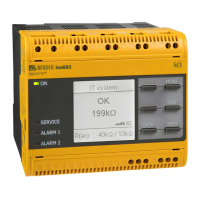
